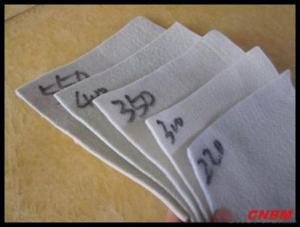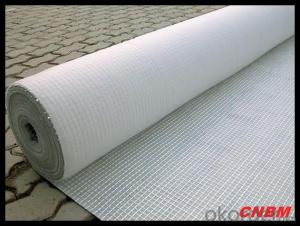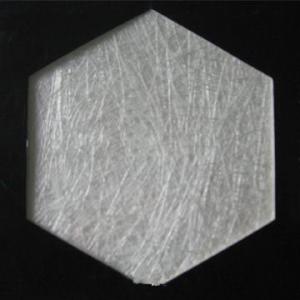Nonwoven Geotextile Drainage Fabric for Reinforcement and Drainage
- Loading Port:
- China main port
- Payment Terms:
- TT OR LC
- Min Order Qty:
- 2000 g/m²
- Supply Capability:
- 1000000 g/m²/month
OKorder Service Pledge
OKorder Financial Service
You Might Also Like
Specification
Features
1)Geotextile can make the water flow easily, and form a drainage channel in the soil, and then make the liquid and gas out of the soil.
Make use of its pulling resistance and deformation resistance that can strength the soil to reinforce the stability of the construction structure and improve the soil’s quality.
2) Make the focus proliferate, deliver and decompose efficiently and prevent the soil from destruction from outside factor.
3) Prevent the top and bottom layer’s gravel, soil and concrete from mixer.
4) The mesh cannot be plugged easily – for the strain and moving quality of the network that formed by the antitype fiber.
5) High soaking quality—at the pressure of soil, it also can keep good soaking quality.
6) Corrosion resistant – using the polypropylene and polyester as raw material, it can resist the sour and aid, erosion, boring and oxidation.
7) The construction is easy; the weight is light, convenient for using, and it making construction easy.
Key Specifications/Special Features:
Specifications
1) PP geotextile: non woven geotextile
2) Material: PP (polypropylene) or Polyester fibers
3) 100g/sq.m-1000g/sq.m
4) Width: 2m-6.5m

1.On a regular basis or as per your request,we entrust national testing agencies to conduct quality inspections
2. Strictly in accordance with the ISO9001-2008 international quality system standard,we monitor and manage the whole process throughout production,quality testing,and measurement to ensure product quality
3. For quality-related construction delay or substandard construction(except for damage or losses due to customer’s responsibility or irresistible natural disasters),we have refunding,replacement,and repair services.We will respond to customers’ feedbacks on quality issues within 24 hours.
After-sales service
1.In order to provide customers with comprehensive technical support,we will provide technical and other related information upon request in a timely manner.
2.In required,we will appoint specialized technicians to the construction site to give technical trainings to construction people,and offer technical guidance throughout the whole construction process.
3.For damage due to shipment and delivery,after we receive the complaint,we will check the issure through provided pictures and videos.If our responsibility is confirmed,we wil offer free replacement.
4.When the construction is completed,as your request,our technical staff may participate in the final acceptance.
FAQ:
Q: What kind of payments does jenor support?
A: T/T, L/C, Cash are accepted.
Q: Do you charge for the samples?
A: Accordeing to our company policy, the samples are free, we only charge the freight fee. And we will return the freight fee during the next order.
Q: Can you produce according to customers' design?
A: Sure, we are professional manufacturer, OEM and ODM are both welcome.
Q: Do you have other products?
A: Yes, please check the pictures:
- Q: Are geotextiles suitable for use in erosion control blankets?
- Yes, geotextiles are suitable for use in erosion control blankets. They are specifically designed to prevent soil erosion by stabilizing the soil and allowing water to pass through while retaining sediment. Geotextiles provide an effective and environmentally friendly solution for erosion control in various applications, including erosion control blankets.
- Q: What are geotextiles?
- Geotextiles are synthetic materials used in civil engineering and construction projects for their specific properties such as filtration, separation, reinforcement, and drainage. They are permeable fabrics that are designed to improve the performance and longevity of soil and other materials in various geotechnical applications.
- Q: How do geotextiles contribute to the sustainability of construction projects?
- Geotextiles contribute to the sustainability of construction projects in several ways. Firstly, they can act as a barrier to prevent soil erosion, which helps to protect the surrounding environment and maintain the integrity of the construction site. Secondly, geotextiles can enhance the stability and longevity of structures by providing reinforcement and improving soil mechanics. This reduces the need for excessive use of materials and resources, making construction projects more sustainable. Additionally, geotextiles can aid in the conservation of water resources by promoting proper drainage and preventing waterlogging. Overall, the use of geotextiles in construction projects helps to minimize environmental impacts while improving the efficiency and durability of structures, contributing to long-term sustainability.
- Q: What is the high strength to strengthen the composite geotextile
- The correct product name should be high-strength reinforced composite geotextile This is a different from the traditional geotextile new products. Reinforced geotextile is made of high-strength fiber tow and non-woven composite weaving, the process is arranged in parallel fiber bundles, give full play to the role of the yarn. Non-woven mat under which the warp technology will be wrapped around the bundle, so that fiber tow and non-woven together, not only to keep the non-woven filter, but also has the strength of woven cloth. Mainly used in: rivers and lakes, drains, reservoir dam control project and power plant ash dam, mine, airport, cargo yard, railway, highway, tunnel, municipal, environmental protection and other projects, with reinforcement, isolation, Drainage, protection and other functions, is an excellent geotechnical materials; the main role is to seepage and isolation of the grassroots level, to prevent soil erosion, sand, and the embankment foundation of the embankment increased tolerance. The superiority is mainly manifested in the following aspects: high strength composite reinforced geotextile anti-aging durability, the service life can reach and more than 100 years; high strength composite geotextile puncture high strength, physical indicators far more conventional geosynthetics Material strength index; high strength composite geotextile friction coefficient, the adhesion is particularly strong, increasing the adhesion of the isolation layer, taking into account the external factors on the impact of reinforced filter layer reduced; high-strength composite geotextile reinforced acid, alkali , Salt corrosion, in the low temperature and high temperature and UV anti-aging experiments, the physical indicators stable.
- Q: Geotextile, 150g how much money per square meter
- 1.2 to 1.5. See quality requirements. Huazhi geotextile material manufacturers
- Q: Can geotextiles be used in pond liner applications?
- Yes, geotextiles can be used in pond liner applications. Geotextiles are commonly used as a protective barrier or reinforcement in pond liners to prevent soil erosion and provide additional stability.
- Q: How do geotextiles contribute to soil moisture retention?
- Geotextiles contribute to soil moisture retention by acting as a barrier that prevents water from evaporating or being lost due to gravity. They allow water to permeate through the soil while preventing excessive drainage, thus promoting better moisture retention in the soil. Additionally, geotextiles also help to reduce soil erosion, which further aids in maintaining soil moisture levels.
- Q: Can geotextiles be used for filtration purposes?
- Yes, geotextiles can be used for filtration purposes. They are specifically designed to allow water to pass through while retaining soil and other particles, making them effective for various filtration applications such as preventing erosion, drainage systems, and sediment control.
- Q: Can geotextiles be used for reinforcement of pipeline trenches?
- Yes, geotextiles can be used for the reinforcement of pipeline trenches. Geotextiles are often used in civil engineering applications to provide additional support and stability to soil structures. In the case of pipeline trenches, geotextiles can be installed to prevent soil erosion and ensure the long-term stability of the pipeline by improving the load-bearing capacity of the surrounding soil.
- Q: Polyester geotextile filter layer sets what the amount
- Polyester filament geotextile Features: Polyester filament geotextile is made by polyester method by spinning acupuncture consolidation directly made, product specifications from 80-800g / m2 arbitrary choice, it is geotechnical engineering and civil engineering In the application of a geosynthetics, polyester filament into a network and consolidation method, the fiber arranged in three-dimensional structure. In addition to good mechanical properties, but also has a good vertical and horizontal drainage performance and good extension properties and high resistance to biological, acid and alkali, anti-aging and other chemical stability. At the same time, it also has a wide pore size range, tortuous pore distribution, excellent permeability and filtration performance. Polyester filament geotextile Uses: water conservancy project dam and slope protection of the filter, channel isolation, seepage; road, rail, airport runway foundation isolation, filter, drainage, slope, retaining wall and road reinforcement, Drainage; Port Engineering soft foundation treatment, beach embankment, harbor wharf and breakwater reinforcement, drainage; polyester filament geotextile has been widely used in the field of infrastructure construction, and gradually applied to a wider range of areas. Geosynthetics are the general term for synthetic materials for civil engineering applications. As a kind of civil engineering material, it is a synthetic polymer (such as plastic, chemical fiber, synthetic rubber, etc.) as raw materials, made of various types of products, placed in the soil, the surface or between the various soil , Play to strengthen or protect the role of soil. "Geosynthetics application of technical specifications" will be divided into geotextile geotextile geotextile, geomembrane, geotextile special materials and geotextile materials, geotextile, fiberglass, geotextile and other types.
Send your message to us
Nonwoven Geotextile Drainage Fabric for Reinforcement and Drainage
- Loading Port:
- China main port
- Payment Terms:
- TT OR LC
- Min Order Qty:
- 2000 g/m²
- Supply Capability:
- 1000000 g/m²/month
OKorder Service Pledge
OKorder Financial Service
Similar products
Hot products
Hot Searches
Related keywords

































